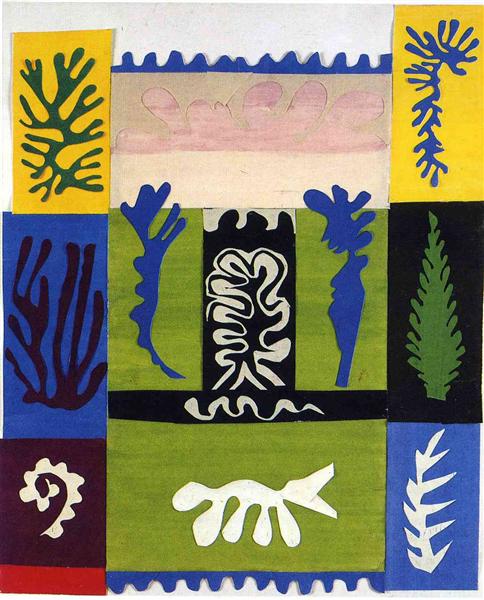Description
Henri Matisse, one of the titans of modern art, made a revolutionary foray into the art world with his series of "cut-outs." His painting "Anfitrite" from 1947, with dimensions of 49x60 cm, is a brilliant example of this unusual and deeply innovative technique. In this work, Matisse abandons traditional painting methods and materials by opting for scissors, paper, and gouache to create compositions of vivid colors and simplified forms.
The figure that titles the work, Anfitrite, is a reference to Greek mythology. Anfitrite, the wife of Poseidon and goddess of the sea, could have been a fitting muse for Matisse, whose compositions frequently evoked the organic vitality and fluidity of the ocean. However, in "Anfitrite," the representation is, in essence, abstract. There is no discernible figure or explicit narrative, but rather a series of cut-out and juxtaposed shapes that suggest an inherent dynamism.
Visually, the painting is defined by marked simplicity and masterful use of color. Matisse employs a range of colors from blue and yellow to green and white, carefully cut into organic and geometric shapes that integrate into a visual dance on the canvas. This vibrant palette and the arrangement of the shapes recall the harmonious complexity found in coral reefs, though stylized in a decidedly modern and abstract manner.
The contrast of colors and shapes creates a visual rhythm that is characteristically Matissean. This dynamic tension between forms and colors seems to emulate a constant flow, similar to the waves of the sea, which can be interpreted as a subtle nod to the character of the goddess Anfitrite.
In terms of composition, "Anfitrite" showcases Matisse's ability to balance disparate elements into a cohesive unity. Each cut-out is placed with precision that suggests both control and spontaneity. The way the paper cut-outs are positioned over each other generates a dimension and depth that transcend the flat surface of the canvas.
A fascinating aspect highlighted in this work is the cut-out technique, or "gouaches découpés," which Matisse began to employ starting in the 1940s. Facing an illness that made painting difficult, the artist reinvented himself and his method, creating works that are just as powerful and expressive as his earlier oil paintings.
"Anfitrite" encapsulates the essence of Matisse's late genius: an art that, in its apparent simplicity, evokes a vastness of meanings and sensations. It is a manifestation of Matisse's ability to reduce the world to its purest essence, distilling form and color into a visual symphony that resonates with creative freedom and continuous innovation. This work is not only an exploration of new techniques but also an affirmation of the eternal spirit of adaptation and reinvention that defined Matisse's career.
In conclusion, "Anfitrite" is not only a testament to Henri Matisse's technical mastery and inventiveness but also a celebration of art's ability to evolve and find new avenues of expression, even in adverse circumstances. This work endures as a symbol of the vitality and ingenuity of one of the greatest artists of the 20th century.

